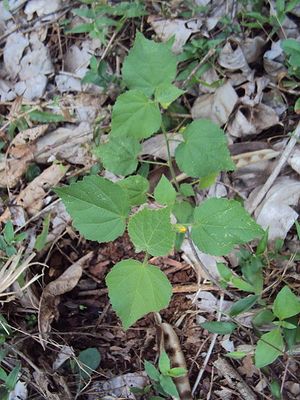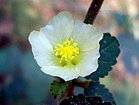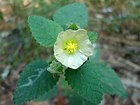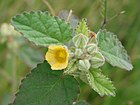Note: This is a project under development. The articles on this wiki are just being initiated and broadly incomplete. You can Help creating new pages.
Difference between revisions of "Sida cordifolia - Bala"
(→References) |
(→External Links) |
||
| Line 90: | Line 90: | ||
==External Links== | ==External Links== | ||
| − | * [http://www.planetayurveda.com/library/bala-sida-cordifolia] | + | * [http://www.planetayurveda.com/library/bala-sida-cordifolia Sida cordifolia on planet ayurveda] |
| − | * [https://www.bimbima.com/ayurveda/herb-information-balasida-cordifolia/614/] | + | * [https://www.bimbima.com/ayurveda/herb-information-balasida-cordifolia/614/ Bala (Sida Cordifolia) Medicinal Use and Health Benefits] |
| − | + | ||
| − | * [https://easyayurveda.com/2012/10/03/country-mallow-sida-cordifolia-ayurveda-details-health-benefits/] | + | * [https://easyayurveda.com/2012/10/03/country-mallow-sida-cordifolia-ayurveda-details-health-benefits/ Sida cordifolia-uses, side effects] |
| − | * [https://www.medindia.net/alternativemedicine/bala.asp] | + | * [https://www.medindia.net/alternativemedicine/bala.asp Sida cordifolia on medindia,net] |
[[Category:Herbs]] | [[Category:Herbs]] | ||
Revision as of 17:51, 2 May 2018
Bala or Sida cordifolia (ilima, flannel weed, bala, country mallow or heart-leaf sida) is a perennial shrub of the mallow family Malvaceae native to India. Sida cordifolia or Bala is a plant. The seeds and root are used to make medicine. Sida cordifolia contains ephedrine, which is an amphetamine-like stimulant that can cause harmful side effects. ... Some people use Sida cordifolia as a stimulant, painkiller, and tonic; and to increase urine production and raise sexual arousal.
Contents
Uses
Bleeding piles, Diarrhea, Fever, Gonorrhea, Aphrodisiac, wounds, Ophthalmia, Painful urination, Paralysis, headache, loss of voice[1]
Parts Used
Chemical Composition
The following alkaloids were reported from S. cordifolia growing in India and β-phenethylamine, ephedrine, pseudo-ephedrine, S-(+)-Nb-methyltryptophan methyl ester, hypaphorine, vasicinone, vasicinol, choline, and betaine.
Common names
| Language | Common name |
|---|---|
| Kannada | Hethutti, Bili kurunthotti |
| Hindi | Bariar, Kungyi Khareti, Kharenti |
| Malayalam | Vellooram, Velluram |
| Tamil | Mayir-manikham |
| Telugu | chirubenda |
| Marathi | NA |
| Gujarathi | NA |
| Punjabi | NA |
| Kashmiri | NA |
| Sanskrit | Bala, Batyalaka |
| English | Country mallow |
Habit
Identification
Leaf
| Kind | Shape | Feature |
|---|---|---|
| serrate | Heart shaped | The leaves are truncate, 2.5-7 cm long and 2.5-5 cm broad, with 7-9 veins |
.[2]
Flower
| Type | Size | Color and composition | Stamen | More information |
|---|---|---|---|---|
| Small | 2.5 cm long | yellow or white in colour | Petals 5 | solitary and axillaries; Calyx campanulate; lobes 5, triangular, densely pubescent outside. Petals 5, pale yellow. Stamens monadelphous and Plant flowers from August to December |
Fruit
| Type | Size | Mass | Appearance | Seeds | More information |
|---|---|---|---|---|---|
| Loculicidal capsule | 7.5–11 cm long, 1.5 cm broad | fruits are with 8 – 10 strongly reticulated mericarps, ciliate on the upper margins and fruiting from October to January. | 12-20 seeds | {{{5}}} | {{{6}}} |
Other features
List of Ayurvedic medicine in which the herb is used
- Vishatinduka Taila as root juice extract
Where to get the saplings
Mode of Propagation
How to plant/cultivate
Prefers a lighter, sandy soil in a sunny position[3]
Commonly seen growing in areas
Tropical, Subtropical plains, Sandy soil.
Photo Gallery
References
External Links
- Pages that are stubs
- Ayurvedic Herbs known to be helpful to treat Bleeding piles
- Ayurvedic Herbs known to be helpful to treat Diarrhea
- Ayurvedic Herbs known to be helpful to treat Fever
- Ayurvedic Herbs known to be helpful to treat Gonorrhea
- Ayurvedic Herbs known to be helpful to treat Aphrodisiac
- Ayurvedic Herbs known to be helpful to treat wounds
- Ayurvedic Herbs known to be helpful to treat Ophthalmia
- Ayurvedic Herbs known to be helpful to treat Painful urination
- Ayurvedic Herbs known to be helpful to treat Paralysis
- Ayurvedic Herbs known to be helpful to treat headache
- Ayurvedic Herbs known to be helpful to treat loss of voice
- Herbs with Root used in medicine
- Herbs with seed used in medicine
- Herbs with Leaves used in medicine
- Herbs with common name in Kannada
- Herbs with common name in Hindi
- Herbs with common name in Malayalam
- Herbs with common name in Tamil
- Herbs with common name in Telugu
- Herbs with common name in Sanskrit
- Herbs with common name in English
- Habit - perennial shrub
- Index of Plants which can be propagated by Seeds
- Herbs that are commonly seen in the region of Tropical
- Herbs that are commonly seen in the region of Subtropical plains
- Herbs that are commonly seen in the region of Sandy soil
- Herbs









